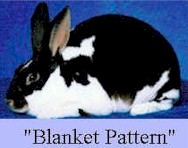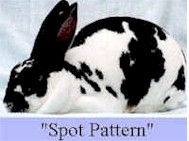Broken Color Genetics
By Cristina Sherer
 One of the most flashy and largest of the varieties is the Broken
Rex. Being a collection of any recognized variety broken up by white spots, makes it more
a group than a specific variety. This color also has many genetic factors that go into
controlling the large variety of patterns gracing our show tables. One pattern type is the
"blanket" which involves a large blanket of color covering the back and
progressing to different degrees down the sides. The other classification is more of an
English spot pattern, which involves a stripe of color down the spine and spots along the
sides in different degrees. Now you wonder how you can plan your breedings to get one or
the other and keep within the standard requirements of no less than 10% color and no more
than 50% color. First lets look at what the genetic make-up of this color is (genotype).
The following chart will list genes in order of dominance and underlined genes apply to
the Broken Rex.
One of the most flashy and largest of the varieties is the Broken
Rex. Being a collection of any recognized variety broken up by white spots, makes it more
a group than a specific variety. This color also has many genetic factors that go into
controlling the large variety of patterns gracing our show tables. One pattern type is the
"blanket" which involves a large blanket of color covering the back and
progressing to different degrees down the sides. The other classification is more of an
English spot pattern, which involves a stripe of color down the spine and spots along the
sides in different degrees. Now you wonder how you can plan your breedings to get one or
the other and keep within the standard requirements of no less than 10% color and no more
than 50% color. First lets look at what the genetic make-up of this color is (genotype).
The following chart will list genes in order of dominance and underlined genes apply to
the Broken Rex.
Broken factor
En En = Charlie (very little color)
En en= Broken
en en = solid
Pattern within colored areas
A = agouti (ring pattern on hair shaft, ex. Castor)
at = tan (ex. Otter)
a = solid (ex. Black)
Base color
B = black
b = chocolate
Type of pigment expressed in hair shaft
C = all pigment expressed (yellow and black, ex. black)
cchd = dark chinchilla (all black pigment ,some yellow, ex. chin or seal)
cchm = medium chinchilla (most of black, some yellow,ex. chin or sable)
cchl = light chinchilla (some of black, some yellow, ex. chin or sable)
ch = Californian (partial albino, only color on points)
c = true albino (total lack of any pigment, including no eye pigment)
Amount of total pigment in hair shaft
D = full color (ex. Black)
d = color is diluted out (ex. Blue)
Extension of black pigment on hair shaft
E5 steel (non-recognized, fills in light areas of agouti and mid band with
black)
E = normal extension (ex. Castor)
eJ = Japanese (ex.Tri color, Harlequin)
e non-extension (ex. Red)
Dutch
Du = normal
dud = dark Dutch, mostly colored area
duw = white Dutch, few colored areas
Wide band
W =normal agouti mid band
w wide mid band
*genes are listed from most dominant (top) to most recessive (bottom) in
that particular
series*
Now if you notice, I have only underlined the En en gene pair in the first list. This is due to the fact that the other genes vary according to what variety is expressed in the colored areas. For example: a Broken Black has the genotype of aa, Bx, Cx, Dx, Ex, Enen. Each aspect of the color is represented by two genes, one from "mom" and one from "dad". The "x' represents any gene below (recessive to) the known gene in the pair or another of the known gene can be paired with it. Since one is dominant and hides its partner we don't know for sure what sits there. This also means a more dominant gene to it is not in this particular rabbit. If it were
it would be expressed, therefore It can't pass on a more dominant gene than the one being expressed as a aspect of a color. This is a important point because this will tell you if you have any hope of seeing a particular color out of a particular cross. The wide band is unknown since it is not an agouti and can not show us and the Dutch gene varies as I will explain.The Dutch gene is a tricky little thorn in our side. It has been found that the Dutch gene lives very close to the Broken gene on the chromosome. In fact, they live so close together they are considered "linked" genes. Since we do not breed for the Dutch markings we tend to forget this gene plays a role in our stock. The Dutch gene operates much like the strange chinchilla series. You can get varying degrees of Dutch spotting depending on the mixture of each gene with another in the list. The good looking Dutch you see on the table are a mixture of dud duw. A Dutch with too much white will often be duwduw. While dud dud, Du dud, and Du duw can be an almost solid rabbit with a white spot or two. Does this last description sound familiar? Yes, it's that annoying bunny that looks like a wonderful solid before you notice the white toe,white toenail or stray white spot on the body. Now keep in mind that most of our rabbits carry a Du Du dominant gene pair that prevents those spots. But if a Broken inherits one of these pesky Dutch recessives would we know it? The answer is no! Your Broken may have a slightly lighter pattern, but how do you know what is causing it. Modifier "helper" genes also control the size of colored areas and the shape of the pattern. Therefore, the Broken is capable of hiding and carrying this annoyance around. This does not mean all Brokens carry the recessive Dutch genes. Many of our Brokens produce fine solids without a problem, but the variety as a whole always has the ability to surprise us.
Another point that is very important to remember is that to get a Broken baby, at least one parent must be Broken. Only Brokens and Charlies carry Broken genes. This gene has what we call partial dominance. The Broken gene is dominant and always expressed if there, but if paired with the recessive solid version you get a normal Broken pattern. If two dominant En genes pair up they work together to produce a extremely light broken pattern or "charlie". This charlie usually has colored ears, and a trace of color around the eyes, nose and body (less than 10% color). Two recessive enen genes give you a solid which is unable to pass on the spotting genes needed. Hence you must have at least one Broken in the breeding pair. Breeding a charlie (EnEn) to a solid (enen) will give you an entire litter of Brokens only. Each kit got a en from the solid and an En from the charlie. If you breed a broken to a broken you get 25% solid, 50% broken and 25% charlies in your litter. If you breed two charlies you will get only charlies. A charlie and a Broken will give you 50% Broken and 50% charlie babies in the litter.
 Another rule of thumb to remember is controlling the degree of
color spotting on your babies. Modifiers are the main players in this area. Modifier genes
are added together to increase or decrease aspects of the colors we raise. For
example, the amount of red glow in a Castor. We have found that breeding Broken to Broken
many times increases the number of white spotting modifiers and increases the amount of
white on an individual (lightens the pattern). While breeding solids into the Broken lines
decreases the amount of white spotting modifiers and decreases white on Broken offspring
(heavier pattern). I will warn you that you need to take a look at the background on your
solid or Broken before breeding. A solid with broken parents or a lot of broken ancestors
may throw pattern you would expect out of a Broken (lighter patterns). The same is true of
a Broken. If you have a Broken with a heavy pattern and solid parents, it may throw heavy
patterns (especially if bred to a solid with a solid background).
Another rule of thumb to remember is controlling the degree of
color spotting on your babies. Modifiers are the main players in this area. Modifier genes
are added together to increase or decrease aspects of the colors we raise. For
example, the amount of red glow in a Castor. We have found that breeding Broken to Broken
many times increases the number of white spotting modifiers and increases the amount of
white on an individual (lightens the pattern). While breeding solids into the Broken lines
decreases the amount of white spotting modifiers and decreases white on Broken offspring
(heavier pattern). I will warn you that you need to take a look at the background on your
solid or Broken before breeding. A solid with broken parents or a lot of broken ancestors
may throw pattern you would expect out of a Broken (lighter patterns). The same is true of
a Broken. If you have a Broken with a heavy pattern and solid parents, it may throw heavy
patterns (especially if bred to a solid with a solid background).
The pattern of the spotting follows the neurological development of the fetus. As you can see, the pattern originates from the head and spine and lightens up as it spreads to the chin, chest and belly. If you can imagine all the pigment producing areas sit in the neural crest of a fetus and as the tissues grow out from that area to supply the rest of the body the pigment producing areas are spread along with them. The more modifiers the less pigment producing areas there are to spread around.
Just remember when you are looking at a Broken you are looking at a variety that has had patches of it's body completely stripped of any pigment (white spots). When you are trying to decide what color your broken pattern is, look at the characteristics of the colored areas. Do they have ring color? (agouti) Do they have shading or points? (Sable, Seal) Do they have eye circles and lighter color in the ears? (Otters and agouties). View the Broken as a big puzzle with missing pieces. The puzzle pieces that are there can tell you what color you have and even to a great extent its quality. That Californian with totally white feet but color on other areas could very well be a broken Cal. Brokens usually have white feet and the absence of color in a Cal can hide the spots that would be apparent on the rest of the body. Sometimes you are also tipped off by a white spot on one of the points also. Are the colored areas free of scattered white hairs? Does the quality of the color meet the standard? This will help you keep the solids in your broken litters nice also. I don't like to look at the Broken variety as a mystery waiting to screw up my solids. keeping your culling strict and keeping in mind the above can help prevent problems.
This variety is both eye catching and fun to breed. You never know what pattern awaits you in the next litter (sometimes not so fun). It seems the more you understand the ways of this variety the easier it is to control its pit falls. It is truly worth the work.